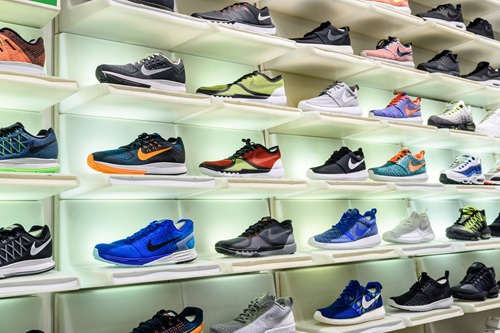
Running events, from local charity 5Ks to elite marathons (and everything in between) are booming in the sports space. In fact, according to Run Repeat, if looking at the change in participation in the last 10 years, there has been an increase in participation of 57.8 percent (from 5 to 7.9 million participants). In terms of popularity, 5K races and half marathons have the highest numbers of participants.
That’s a lot of feet on the asphalt and on the trail as well. It’s also a lot of shoes being used and discarded (or given to thrift store pickups where, if shoes look worn, they will be tossed).
It’s not an insignificant problem, says Women’s Running. The shoe industry produces 24.2 billion pairs a year, along with a great deal of waste. The life cycle (from material processing, manufacturing, logistics, and eventual waste) is estimated to create 30 pounds of carbon emissions for each pair of running shoes.
Pretty grim statistics, all in all. However, there are options available to recycle shoes. And if running events partner with these programs, it can buy some serious good will in the community.
 Consider the case of Nike Grind. According to the website, “In the early 90s, two Nike employees wanted to find a way to keep end-of-life athletic shoes from ending up in landfills, but quickly realized there was no such thing as a shoe recycling machine. So, they set out to invent one.
Consider the case of Nike Grind. According to the website, “In the early 90s, two Nike employees wanted to find a way to keep end-of-life athletic shoes from ending up in landfills, but quickly realized there was no such thing as a shoe recycling machine. So, they set out to invent one.
Through trial and error that included microwaves, water jets and a ruined family clothes dryer, they eventually came up with a way to transform whole shoes into reusable materials. The basketball court surface at the Nike facility in Wilsonville, Oregon was the first test use of that recycled material. And with that, the Nike Grind program was born, and a company-wide push towards sustainability and circularity began.”
Today, Nike Grind is used in running track surfaces, courts, walkways and playground floors, as well as weight room flooring and other materials. Some products are high-end but many others go to underserved populations. For example, in 2006, Nike donated 40,000 soccer balls made from Grind materials to refugee camps in Azerbaijan, Uganda and Thailand. In 2013, the Kevin Durant Charity Foundation used Nike Grind to renovate and resurface a basketball court for underserved youth. The Reuse-A-Shoe program, where shoes can be dropped off, is available at select Nike stores.
Multiple running stores, as well as local running clubs, have begun collection efforts for running shoes. And Nike isn’t the only game in town. In Maryland, Charm City Run, a running and walking specialty company with seven locations , collects running and walking shoes using MORE Foundation Group donation boxes. Additionally, shoes are collected at races put on by Charm City Run throughout the year. MORE Foundation donation boxes hold 40 to 50 pairs of shoes each and come with a prepaid shipping label. Proceeds from the shoes fund MORE’s ongoing reforestation projects.
Another program, Soles4Souls, partners with community-based nonprofit organizations in developing countries to help entrepreneurs start and grow businesses that sell donated shoes and clothing. Soles4Souls also partners with schools across the U.S. to get new athletic shoes to children who are experiencing homelessness, eliminating a barrier to educational and extracurricular opportunities.
And that’s just the beginning. Google terms like “sneaker recycling,” “recycle tennis shoes,” “recycle running shoes” or anything else, and you’ll get plenty of hits.
Unfortunately, not all efforts are legitimate. For example, Runner’s World covered the case of Dow Chemical Company, which collected old running shoes with the promise of turning them into running tracks and playgrounds in developing countries. The shoes, as it turned out, were being sold at flea markets. Talk about looking like a heel.
 Essential points for event owners to note when considering shoe recycling partners:
Essential points for event owners to note when considering shoe recycling partners:
- Vet organizations carefully to ascertain they are legitimate; programs like the Better Business Bureau and Charity Navigator can help
- Research beforehand by doing Google searches on shoe recycling in your city, or in the host city of an event – or look for nationwide programs
- Research what fees apply (some companies may just require event owners to pay shipping for shoes, some may have prepaid postage and others may charge by weight or number of shoes collected)
- Find out exactly what types of shoes organizations can accept. Some deal only with sports shoes while others may have a broader scope.
- Remember that participants may be so enthusiastic about donating items that they may not sort shoes but may bring cartons containing all shoes (including dress shoes) and dump them all at once – so event owners or volunteers will likely need to spend some time parsing through donations prior to sending them off. Some donations may need to be passed along to local charities (many have receptables and bins into which shoes can be put) if the sneaker recycling partner cannot use them.
- If you are planning to have a box onsite into which shoes can be dropped, remember that the amount donated may exceed the receptacle’s capacity; it may be better to have a tent where volunteers accept and sort awards, and thank people for donating.
- Do a press release to local media, promoting both the event and its ability to recycle shoes. A box overflowing with used shoes is an excellent visual that will likely get picked up for coverage.

